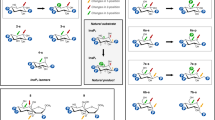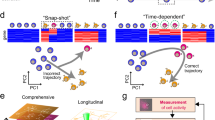Abstract
T lymphocytes can be activated in a variety of ways, including occupancy of the T cell antigen receptor (TCR) complex or cross-linking of certain cell-surface molecules with antibody1–4. Two of the earliest events seen after stimulation are the hydrolysis of phosphatidylinositol bisphosphate to inositol trisphosphate (Ins P3) and 1,2-diacylglycerol (DAG)5–7, and an increase in the concentration of intracellular Ca2+ ([Ca2+]i)8–11. Later, the cell secretes lymphokines and expresses lymphokine receptors1. It has been postulated that the products of the hydrolysis of phosphatidylinositols (Ptd Ins) and fluctuations in [Ca2+]i are critical 'second messengers≈, transmitting the signals for the initiation of the later events. We have examined the relationship between these second messengers and the secretion of IL-2 in a murine T cell variant whose missing TCR complex had been reconstituted by gene transfer. Surprisingly, although the IL-2 responses of the transfectant could not be distinguished from the original line expressing the same TCR, Ptd Ins hydrolysis and the increase in [Ca2+]i were substantially reduced or absent in the reconstituted cell. It is therefore possible to dissociate these early biochemical changes from a late biological response, raising questions about the putative causal relationship of these events.
This is a preview of subscription content, access via your institution
Access options
Subscribe to this journal
Receive 51 print issues and online access
$199.00 per year
only $3.90 per issue
Buy this article
- Purchase on SpringerLink
- Instant access to full article PDF
Prices may be subject to local taxes which are calculated during checkout
Similar content being viewed by others
References
Ashman, R. F. in Fundamental Immunology (Raven, New York, 1984).
Gunter, K. C., Malek, T. R. & Shevach, E. M. J. exp. Med. 159, 716–730 (1984).
Malek, T. R., Ortega, G., Chan, C., Kroczek, R. A. & Shevach, E. M. J. exp. Med. 164, 709–722 (1986).
Meuer, S. C. et al. Cell 36, 897–906 (1984).
Resch, K., Gelfand, E. W., Hansen, K. & Ferber, E. Eur. J. Immun. 2, 598–601 (1972).
Hui, D. Y. & Harmony, J. A. K. Biochem. J. 192, 91–98 (1980).
Imboden, J. B. & Stobo, J. D. J. exp. Med. 161, 446–456 (1985).
Allwood, G., Asherson, G. L., Davey, M. J. & Goodford, P. J. Immun. 21, 509–516 (1971).
Whitney, R. B. & Sutherland, R. M. Cell Immun. 5, 137–147 (1972).
Tsien, R. Y., Pozzan, T. & Rink, T. J. Nature 295, 68–71 (1982).
Weiss, A., Imboden, J., Shoback, D. & Stobo, J. Proc. natn Acad. Sci. U.S.A. 81, 4169–4173 (1984).
Sussman, J. J., Saito, T., Shevach, E. M., Germain, R. N. & Ashwell, J. D. J. Immun. 140, 2520–2526 (1988).
Besterman, J. M., Duronio, V. & Cuatrecasas, P. Proc. natn Acad. Sci. U.S.A. 83, 6785–6789 (1986).
Kennerly, D. A. J. biol. Chem. 34, 16305–16313 (1987).
Berridge, M. J. Biochem. J. 220, 345–360 (1984).
Whitaker, M. & Irvine, R. R. Nature 312, 636–639 (1984).
Stewart, S. J. et al. Proc. natn. Acad. Sci. U.S.A. 83, 6098–6102 (1986).
Irvine, R. F. & Moor, R. M. Biochem. J. 240, 917–920 (1986).
Kuno, M. & Gardner, P. Nature 326, 301–304 (1987).
Weiss, A. & Stobo, J. D. J. exp. Med. 160, 1284–1299 (1984).
Truneh, A., Albert, F., Golstein, P. & Schmitt-Verhulst, A.-M. Nature 313, 318–320 (1985).
Alford, R. H. J. Immun. 104, 698–703 (1970).
Whitney, R. B. & Sutherland, R. M. J. cell Physiol. 80, 329–338 (1972).
Freedman, M. H. Cell. Immun. 44, 290–313 (1979).
Sternweis, P. C. & Gilman, A. G. Proc. natn. Acad. Sci. U.S.A. 79, 4888–4891 (1982).
Blackmore, P. F., Bocckino, S. B., Waynick, L. E. & Exton, J. H. J. biol. Chem. 260, 14477–14483 (1985).
Strnad, C. F. & Wong, K. Biochem. Biophys. Res. Commun. 133, 161–167 (1985).
O'Shea, J. J. et al. J. Immun. 139, 3463–3469 (1987).
Gelfand, E. W., Cheung, R. K., Mills, G. B. & Grinstein, S. Nature 315, 419–420 (1985).
Roifman, C. M. et al. Eur. J. Immun. 17, 1737–1742 (1987).
Woldemussie, E., Ali, H., Takaishi, T., Siraganian, R. P. & Beaven, M. A. J. Immun. 139, 2431–2438 (1987).
Mercep, M., Bluestone, J. A., Noguchi, P. D. & Ashwell, J. D. J. Immun. 140, 324–335 (1988).
Leo, O., Foo, M., Sachs, D. H., Samelson, L. E. & Bluestone, J. A. Proc. natn. Acad. Sci. U.S.A 84, 1374–1378 (1987).
Corradin, G. & Harbury, H. A. Biochim. biophys. Acta. 221, 489–496 (1970).
Kappler, J., White, J., Wegmann, D., Mustain, E. & Marrack, P. Proc. natn. Acad. Sci. U.S.A. 79, 3604–3607 (1982).
Berridge, M. J. Biochem. J. 212, 849–858 (1983).
Folch, J., Lees, M. & Sloane-Stanley, G. H. J. biol. Chem. 226, 497–509 (1957).
Fine, B. J. & Sprecher, H. J. Lipid Res. 23, 660–663 (1982).
Treves, S. et al. J. exp. Med. 166, 33–42 (1987).
Grynkiewicz, G., Poenie, M. & Tsien, R. Y. J. biol. Chem. 260, 3440–3450 (1985).
Author information
Authors and Affiliations
Rights and permissions
About this article
Cite this article
Sussman, J., Mercép, M., Saito, T. et al. Dissociation of phosphoinositide hydrolysis and Ca2+ fluxes from the biological responses of a T-cell hybridoma. Nature 334, 625–628 (1988). https://doi.org/10.1038/334625a0
Received:
Accepted:
Issue date:
DOI: https://doi.org/10.1038/334625a0



